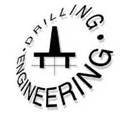 Extension of Pipe Flow Equations to Annular Geometry
Extension of Pipe Flow Equations to Annular Geometry
A large amount of experimental work relating flowrate to pressure losses has been conducted in circular pipes. Unfortunately however, very little experimental work
has been conducted in flow conduits of other shapes, such as annular geometries. When noncircular flow conduits are encountered, a common practice is to calculate an ‘effective circular diameter’ such that the flow behaviour in a circular pipe of that diameter would be roughly equivalent to the flow behaviour in the noncircular conduit. This effective diameter can be used in the Reynolds number and other flow equations to represent the size of the conduit. One criterion often used in determining an equivalent circular diameter for a noncircular conduit is the ratio of the cross-sectional area to the wetted perimeter of the flow channel. This ratio is called the hydraulic radius. For the case of an annulus, the hydraulic radius is given by:
r d2-d1
rH — л
Equation 19 Hydraulic Radius
The equivalent circular diameter is equal to four times the hydraulic radius.
de = 4 rH = d2 — d1
Equation 20 Equivalent Circular Diameter
Note that for d1= 0 (no inner pipe) the equivalent diameter correctly reduces to the diameter of the outer pipe.
A second criterion used to obtain an equivalent circular radius is the geometry term in the pressure-loss equation for laminar flow. Consider the pressure loss equations for pipe flow and concentric annular flow of Newtonian fluids given in Equations 7 and 8. Comparing the geometry terms in these two equations yields:
л Г2 d2-d?
de= Jd++d1—————- 2—
e y + 1 ln(d2 / di)
Equation 21 Equivalent Circular Diameter 2
A third expression for the equivalent diameter of an annulus can be obtained by comparing the equation for pressure loss in slot flow :
de = 0.816 (d2 — d1)
Equation 22 Equivalemnt Circular Diameter 3
For most annular geometries encountered in drilling operations, d1/d2 > 0.3, and Equations 21 and 22 give almost identical results.
|
|
All three expressions for equivalent diameter shown above have been used in practice to represent annular flow. Equation 20 is probably the most widely used in the petroleum industry. However, this is probably due to the simplicity of the method rather than a superior accuracy.
